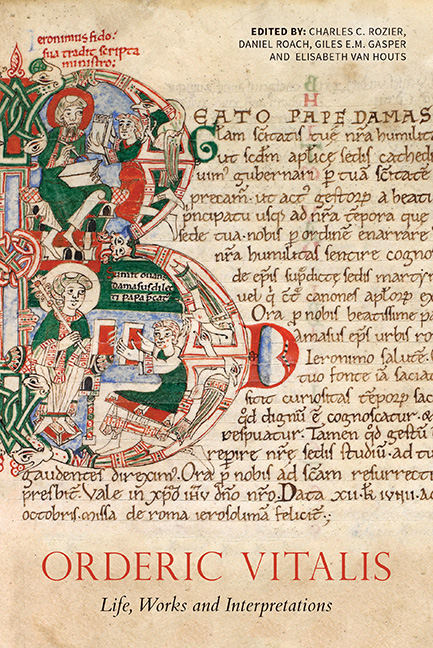Book contents
- Frontmatter
- Dedication
- Contents
- List of Illustrations
- Acknowledgements
- List of Abbreviations
- Chronology of the Lives of Odelerius and his Son Orderic Vitalis
- Composition of the Historia ecclesiastica
- Introduction: Interpreting Orderic Vitalis
- Orderic and his Father, Odelerius
- Following the Master's Lead: The Script of Orderic Vitalis and the Discovery of a New Manuscript (Rouen, BM, 540)
- Orderic Vitalis as Librarian and Cantor of Saint-Évroul
- Saint-Évroul and Southern Italy in Orderic's Historia ecclesiastica
- Orderic and English
- Inscriptions in Orderic's Historia ecclesiastica: A Writing Technique between History and Poetry
- Reading Orderic with Charters in Mind
- Orderic Vitalis and the Cult of Saints
- Orderic's Secular Rulers and Representations of Personality and Power in the Historia ecclesiastica
- Worldly Woe and Heavenly Joy: The Tone of the Historia ecclesiastica
- Orderic Vitalis, Historical Writing and a Theology of Reckoning
- Jesus Christ, a Protagonist of Anglo-Norman History? History and Theology in Orderic Vitalis's Historia ecclesiastica
- ‘Studiosi abdita investigant’: Orderic Vitalis and the Mystical Morals of History
- Meanders, Loops, and Dead Ends: Literary Form and the Common Life in Orderic's Historia ecclesiastica
- Orderic and the Tironensians
- ‘One single letter remained in excess of all his sins …’: Orderic Vitalis and Cultural Memory
- The Reception of Orderic Vitalis in the Later Middle Ages
- Appendix 1 Archaeological Investigations at the Abbey of Saint-Évroult-Notre-Dame-des-Bois
- Appendix 2 Descriptive Catalogue of Manuscripts Featuring the Hand of Orderic Vitalis
- Select Bibliography
- List of Manuscripts Cited
- General Index
Orderic and his Father, Odelerius
Published online by Cambridge University Press: 25 October 2017
- Frontmatter
- Dedication
- Contents
- List of Illustrations
- Acknowledgements
- List of Abbreviations
- Chronology of the Lives of Odelerius and his Son Orderic Vitalis
- Composition of the Historia ecclesiastica
- Introduction: Interpreting Orderic Vitalis
- Orderic and his Father, Odelerius
- Following the Master's Lead: The Script of Orderic Vitalis and the Discovery of a New Manuscript (Rouen, BM, 540)
- Orderic Vitalis as Librarian and Cantor of Saint-Évroul
- Saint-Évroul and Southern Italy in Orderic's Historia ecclesiastica
- Orderic and English
- Inscriptions in Orderic's Historia ecclesiastica: A Writing Technique between History and Poetry
- Reading Orderic with Charters in Mind
- Orderic Vitalis and the Cult of Saints
- Orderic's Secular Rulers and Representations of Personality and Power in the Historia ecclesiastica
- Worldly Woe and Heavenly Joy: The Tone of the Historia ecclesiastica
- Orderic Vitalis, Historical Writing and a Theology of Reckoning
- Jesus Christ, a Protagonist of Anglo-Norman History? History and Theology in Orderic Vitalis's Historia ecclesiastica
- ‘Studiosi abdita investigant’: Orderic Vitalis and the Mystical Morals of History
- Meanders, Loops, and Dead Ends: Literary Form and the Common Life in Orderic's Historia ecclesiastica
- Orderic and the Tironensians
- ‘One single letter remained in excess of all his sins …’: Orderic Vitalis and Cultural Memory
- The Reception of Orderic Vitalis in the Later Middle Ages
- Appendix 1 Archaeological Investigations at the Abbey of Saint-Évroult-Notre-Dame-des-Bois
- Appendix 2 Descriptive Catalogue of Manuscripts Featuring the Hand of Orderic Vitalis
- Select Bibliography
- List of Manuscripts Cited
- General Index
Summary
Much has been written about autobiographical writing or, to use the phrase coined in the 1970s by Michel Foucault, ‘self-writing’. In the Middle Ages the two were not the same. We have to distinguish between an author writing about himself from the start, focusing on his own life and thoughts (‘autobiographie’), and an author on occasion inserting details about himself in any kind of narrative (self-writing). The medieval period is framed by two famous autobiographies: St Augustine's Confessiones, written c. 397×400, and Petrarch's Letters and Secretum, composed c. 1347×1153. In the time of Orderic Vitalis the autobiographies of two Benedictine monks, Guibert of Nogent (c. 1055–c. 1125) and Peter Abelard (1072–1142), stand out as full-scale narratives about the self. Guibert wrote his De vita sua towards the end of his life, in 1114–15, a decade or so into his abbacy at Nogent-sous-Coucy. Peter Abelard's Historia calamitatum was composed in the early 1130s about fifteen years after the most traumatic incident of his life – his castration by Fulbert, the uncle-canon of his lover, Heloise, in Paris. These autobiographies represent the trend for the rediscovery of the individual in the twelfth-century renaissance, when self-examination came to form part of the penitential process of the individual monk. There were various ways in which the medieval monk, as part of a closed-off community, engaged with his inner thoughts. However, such preoccupation with interiority was not concerned, as it would now be, with understanding one's character and psychology, but with coming closer to God. The rise of the autobiography is at the same time linked with the flourishing of historical writing in which historians included themselves as actors in their narratives. Yet, the focus on well-known authors should not blind us to the fact that throughout the Middle Ages many historians, whether they were modest annalists, chroniclers, hagiographers or authors of substantial histories, inserted information about themselves into their books. While most did so anonymously, a few included details about their own lives. It is as one of the latter category that I will discuss Orderic Vitalis (1075–c. 1142).
- Type
- Chapter
- Information
- Orderic Vitalis: Life, Works and Interpretations , pp. 17 - 36Publisher: Boydell & BrewerPrint publication year: 2016



